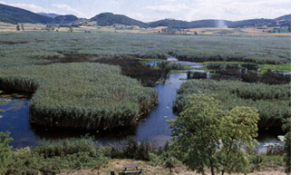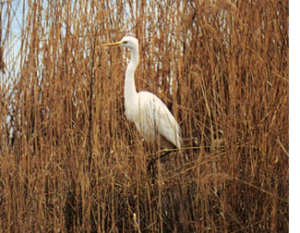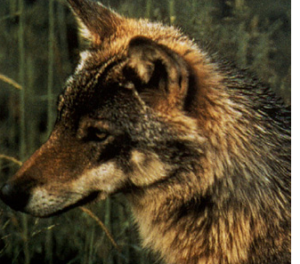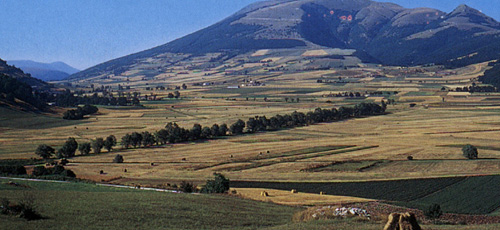 The richness of the wildlife community in the Colfiorito plateaus is to be found in the environmental diversity that these places are able to offer. Crops, woods, meadows, pastures and both perennial and seasonal wetlands constitute different habitats in which many vertebrates find ideal living conditions.
The richness of the wildlife community in the Colfiorito plateaus is to be found in the environmental diversity that these places are able to offer. Crops, woods, meadows, pastures and both perennial and seasonal wetlands constitute different habitats in which many vertebrates find ideal living conditions.
The swamp, located in the immediate vicinity of the town of Colfiorito, is home to various species of fish, mainly the result of repopulations carried out over the last 20 years. Rather common is the tench (Tinca tinca), which together with the eel (Anguilla anguilla) and the carp (Cyprinus carpia) constitutes the majority of the fish biomass of the wetland, today also inhabited by alien forms of oriental origin such as the crucian carp ( Crucian carp (Carassius carassius) and the golden crucian carp (Carassius auratus).
Among amphibians, in addition to the green frog (Rana esculenta) and the crested newt (Triturus cristatus carnijfex), the presence of species in sharp decline in our peninsula such as the Greek frog (Rana Grecia) and the agile frog (Rana damaltina) is significant. , while for reptiles the presence of the snake snake (Caluber viridiflavus), the grass snake (Natrix natrix) and the tassel snake (Natrix tassellata) has been ascertained, which together with the red snake (Elaphe quatuorlineara) are the ophidians of greatest conservation interest.
The birds, whose specific consistency varies over the seasons, are particularly abundant in the spring and autumn migration periods thanks above all to the places of refuge and feeding represented by the Colfiorito Marsh and the karst plains of Ricciano, Annifo and Arvello. It is precisely in these periods that you can practice excellent birdwatching by observing, with a bit of luck, unusual species for our latitudes such as the rare croccolone (Gallinaga media) and bluethroat (Luscinia svecica), the mighty osprey (Pandion haliaetuì ) and the elegant white stork (Cicania ciconia).
The Colfiorito Marsh, already included in the Ramsar Convention which underlines its international importance, especially as a habitat for aquatic birds, constitutes the most naturalistically relevant portion of the entire area. It is precisely within this biotope that the bittern (Bataurus stellaris), one of the rarest and most threatened species of the entire European ornithofauna, finds its living space. The presence of this ardeid, a typical inhabitant of extensive reed thickets and rushes, is betrayed by its very particular territorial song, similar to a real “moo”, audible from late winter until the beginning of the summer season. Thanks to observations and studies conducted since 1993, a surprising situation has emerged, to say the least. This small wetland is in fact home to one of the most important Italian populations of bitterns whose national population is around 20-30 nesting pairs (Brichetti, 1992).
 The extensive reed thickets and rushes which, together with the high environmental quality of the area, are probably at the basis of this small ornithological miracle also host other interesting bird species in the summer period such as the purple heron (Ardea purpurea), the little bittern ( Ixobrvchus minutus) and the rowdy warbler (Acrocephalus scirpaceus) and warbler (Acrocephalus arundinaceus).
The extensive reed thickets and rushes which, together with the high environmental quality of the area, are probably at the basis of this small ornithological miracle also host other interesting bird species in the summer period such as the purple heron (Ardea purpurea), the little bittern ( Ixobrvchus minutus) and the rowdy warbler (Acrocephalus scirpaceus) and warbler (Acrocephalus arundinaceus).
Particularly common in the marsh and observable for most of the year are the mallard (Anas platyrhynchos), the coot (Fulica atra), the moorhen (Gaimula chloropus), the water rail (Rallus aquaticus), the gray heron ( Ardea cinerea), the pendulum (Remiz pendulinus) and the colorful whisker (Panurus biarmicus), while in winter, in addition to admiring the aerial evolutions of the marsh harrier (Circus aeroginosu, of the hen harrier (Circus cyaneus) and the elegance of great egret (Egretta alba), it is easy to come across large groups of snipe (Gallinago gallinago), teals (Anas crecca), wigeons (Anas penelope) and pochards (Aythya ferme).
The Colfiorito plateaus do not only mean aquatic birds, there are many interesting forestry species and those linked to the agro-ecosystem including: buzzard (Buteo buteo), sparrowhawk (Accipiter nisus), kestrel (Falco tinnunculus), barn owl (Tyto alba ), tawny owl (Strix aluco), great spotted woodpecker (Dendrocopus major), skylark (Alauda arvensis), nuthatch (Sitta earopaea), stonechat (Saxicola torquata), pipit (anthus trivialis), wagtail (Motacilla flava), little shrike ( Lanius collurio), blackhammer (Emberiza cinlus) and ortolan bunting (Embeniza bortulana).
 The class of mammals is represented by species whose habits, generally crepuscular, and extreme elusiveness make observation problematic. Among insectivores, even if specific studies in this regard are lacking, the presence of the hedgehog (Erinaceus europaeus), the water shrew (Neomysfodies), the common shrew (Sorex araneus) and the red shrew (Crocidura russula) has been confirmed.
The class of mammals is represented by species whose habits, generally crepuscular, and extreme elusiveness make observation problematic. Among insectivores, even if specific studies in this regard are lacking, the presence of the hedgehog (Erinaceus europaeus), the water shrew (Neomysfodies), the common shrew (Sorex araneus) and the red shrew (Crocidura russula) has been confirmed.
Without notable particularities is the world of rodents, which finds the most common elements in highland area. The common hare (Lepus europaeus), easily detectable in grassland and uncultivated areas, is characterized by a population whose size is rather variable, dependent on the intensity of hunting activity. The most valuable element of the mammal fauna in the highlands is the wolf (Canis lupus) which actively frequents the area. The presence of the large predator, ascertained among other things by the discovery of the remains of two individuals near the Piano di Arvello (1993) and at the edge of the Cupigliulo scrub (1995), is detectable especially in winter when the snow cover highlights its typical slopes.
In addition to the wolf, the other carnivores found in the area are the fox (Vulpes vulpes), the weasel (Mustela nivalis) and the fama (Martes fama). Among the ungulates, the wild boar (Sus scrofa) is common, while the sightings of roe deer (Capreolus capreolus) are rare and occasional, the presence of which, given the suitability of the area, should certainly be encouraged.

